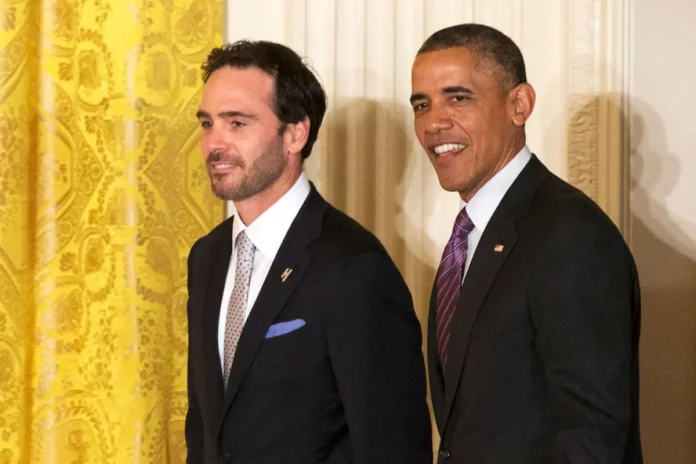Jimmie Johnson’s Meeting With Barack Obama: In 2009, Jimmie Johnson‘s White House visit to commemorate his third consecutive NASCAR championship sparked a surprising dialogue with President Barack Obama. The conversation transcended typical political discussions, as they examined the intricacies of racing, including vehicle features and safety technologies. Johnson humorously recounted his experiences with speeding tickets, while both figures shared a mutual respect for success and excellence.
Key Highlights
- Jimmie Johnson visited the White House in 2009 to celebrate his third consecutive NASCAR Cup Series championship with President Obama.
- The meeting featured an engaging discussion about the specifications and safety technologies of Johnson’s iconic No. 48 Chevy.
- Obama inquired about Johnson’s racing experiences, including humorous questions about speeding tickets, showcasing a light-hearted connection.
- The dialogue highlighted NASCAR’s cultural significance and its role as a unifying force in American society.
- Mutual respect for excellence in sports was evident, as both Johnson and Obama shared admiration for achievements in their respective fields.
Jimmie Johnson’s Visit to the White House in 2009
In 2009, Jimmie Johnson made a memorable entrance into the White House, seamlessly merging the worlds of politics and sports. This notable event unfolded against the backdrop of Johnson’s remarkable achievement of securing his third consecutive NASCAR Cup Series championship. The meeting not only celebrated Johnson’s victories but also symbolized a unique intersection of American culture, where the domains of motorsport and governance converged.
Upon arriving, Johnson displayed his iconic 48 Chevy, inviting then-President Barack Obama to investigate the intricacies of the vehicle. This moment was not merely a display of automotive skill; it served as an opportunity for dialogue between two influential figures from vastly different spheres. As Johnson detailed the car’s specifications and advanced safety features, Obama’s genuine curiosity reflected a broader interest in the importance of NASCAR within American society.
The exchange highlighted the evolving nature of sports, particularly how it resonates with diverse audiences and fosters connections across multiple demographics. The light-hearted banter surrounding the car’s dashboard emphasized the contrast between the high-octane world of NASCAR and the everyday realities of political life.
Johnson’s ability to engage with the President in such an informal yet meaningful manner showcased the power of sports as a unifying force. This encounter exemplified not only a celebration of individual achievement but also the potential for shared experiences to bridge gaps between disparate sectors, fostering a greater understanding of the cultural landscape in which both figures operate.
Barack Obama’s Interaction with Jimmie Johnson
During their meeting, Barack Obama engaged Jimmie Johnson in an open conversation that transcended the boundaries of their respective fields. This unexpected interchange not only displayed the human side of both figures but also illuminated the intersection of politics and sports.
Obama’s inquiry about Johnson’s racing experiences, particularly regarding speeding tickets, revealed a deeper understanding of the strain faced by athletes in high-adrenaline professions. Johnson’s response—“I’m able to get out my aggression on the track and keep it off the streets”—underscored the significance of controlled environments for managing personal impulses, a theme that resonates beyond the domain of NASCAR.

This dialogue also served as a reflection of Johnson’s remarkable career, which was marked by a historic achievement of five consecutive championships. The conversation, while casual, was steeped in the acknowledgment of the dedication and discipline required to excel at such a high level.
Johnson’s skill on the racetrack has not only entertained millions but has also provided a lens through which the complexities of competitive sports can be examined, including the balance of risk and control.
As the discussion unfolded, it became evident that both men, despite their different backgrounds, shared a mutual respect for excellence and the relentless pursuit of success.
Jimmie Johnson’s Transition to Part-Time Racing
As Jimmie Johnson accepts a new phase in his illustrious career, his shift to part-time racing marks a significant change not only for him but also for the NASCAR landscape.
Shifting from a full-time competitor to a part-time racer, Johnson—now 49—continues to wield considerable influence in the sport while embracing a different role. His move coincides with his newfound position as a part-owner of the Legacy Motor Club, where he channels his expertise into building and engineering two full-time entries in the Cup Series.
Johnson’s career is a reflection of resilience and excellence, as he amassed 83 wins over two decades, solidifying his status as one of NASCAR’s all-time greats.
However, the decision to step back from full-time racing reflects a tactical pivot, allowing him to utilize his extensive experience while nurturing the next generation of drivers.
This dual focus not only positions him as a mentor but also as a crucial contributor to the sport’s future.
Jimmie Johnson’s Plans for the 2025 Season
With Jimmie Johnson now firmly established in his role as a part-time racer and part-owner of the Legacy Motor Club, the focus shifts to his tactical plans for the 2025 season. Johnson’s intent is to utilize the No. 84 car strategically, ensuring it complements the efforts of the Nos. 42 and 43 without detracting from their performance. His commitment to a results-oriented approach highlights the seriousness with which he regards this endeavor.
“For 2025, we will make sure we use the [No. 84] car in the right capacity and in the right way so it doesn’t take anything away from the [Nos.] 42 or the 43, We will see how many times Jacob [Canter, director of competition at Legacy Motor Club] lets me go out and drive.” – Jimmie Johnson
In a recent conversation, Johnson articulated the importance of setting clear goals for the auxiliary car, stating, “Picking a goal, having a reason and a purpose for why we’re running a auxiliary car is very helpful.” This insight reflects his analytical mindset and commitment to excellence, as he prepares for a competitive landscape that has seen the No. 42 and 43 struggle for top finishes.
Jimmie Johnson will drive in select races next year for Legacy Motor Club.
"I’m a result-oriented guy. It’s hard not to have that weigh on you at times. Picking a goal, having a reason and a purpose for why we’re running a third car is very helpful."https://t.co/yNQEMFWKk2
— Dustin Albino (@DustinAlbino) November 12, 2024
As the Legacy Motor Club undergoes changes, including a new crew chief for John Hunter Nemechek, Johnson’s leadership will be crucial in maneuvering the complexities of a part-time season. His analytical approach will not only guide his own racing but also foster the growth of the team as they aim for success on the track.
News in Brief: Jimmie Johnson’s Meeting With Barack Obama
The historic meeting between Jimmie Johnson and Barack Obama emphasizes the intersection of sports and politics, highlighting the cultural significance of NASCAR in American society. Johnson’s shift to part-time racing reflects the evolving nature of athletic careers, alongside personal aspirations beyond competition.
With plans for the 2025 season, Johnson’s path continues to captivate audiences, illustrating the enduring impact of professional athletes in shaping broader narratives within the sports landscape and fostering connections across diverse spheres.
ALSO READ: Jimmie Johnson’s Legacy Motor Club a Circus? NASCAR Analyst Questions Team’s Future





